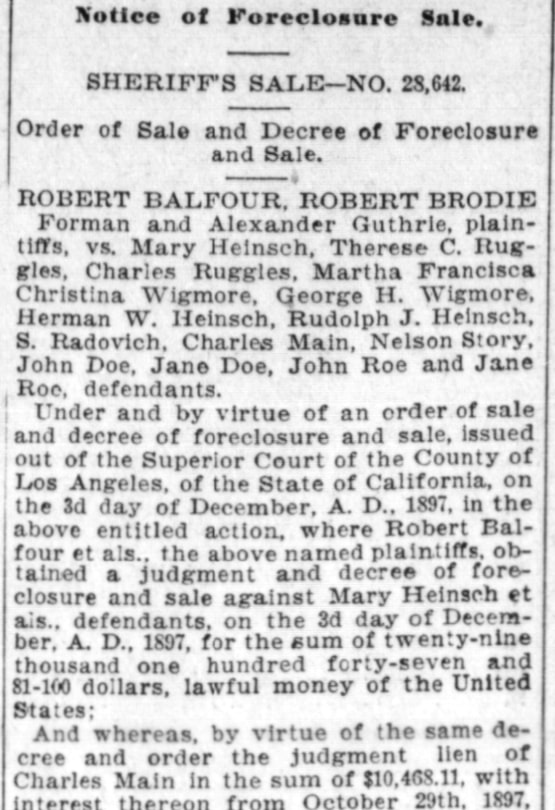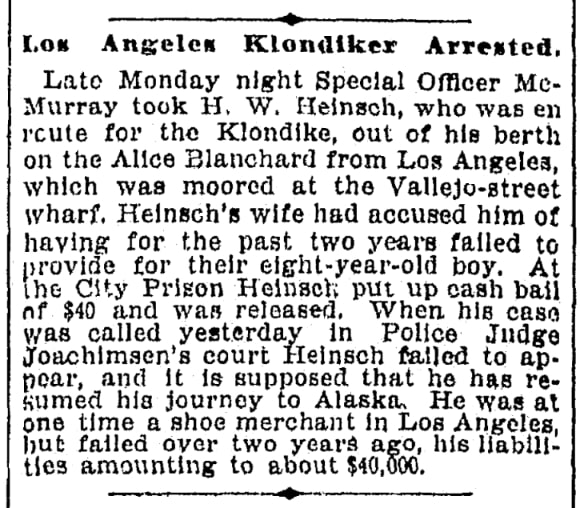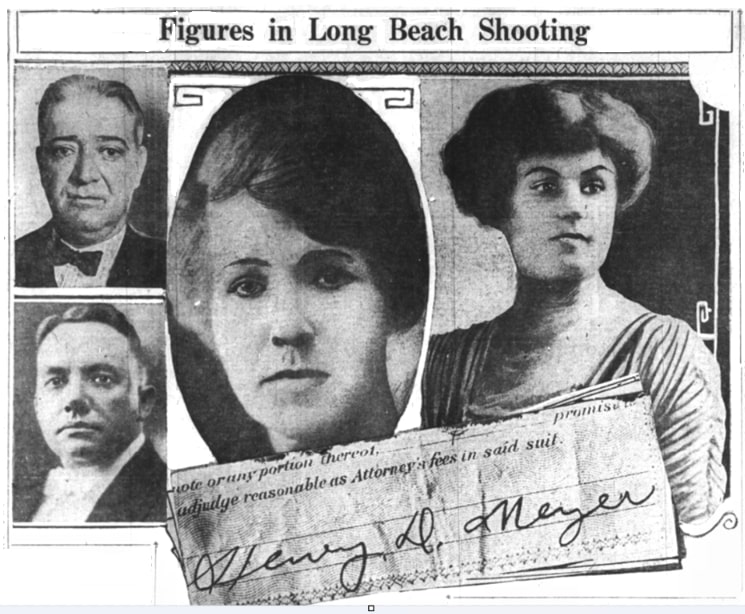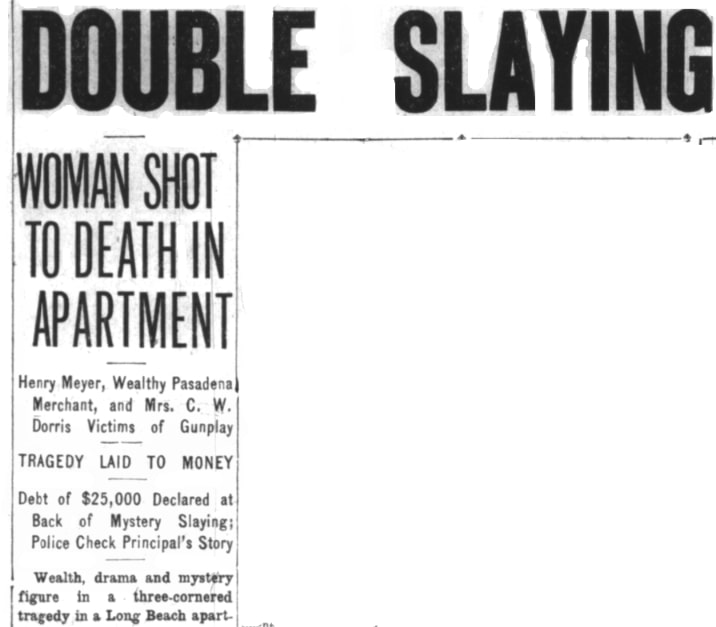Introduction: In this article, the plot thickens as James Pylant looks into the “whodunnit” case of Charlie Dorris and a puzzling double slaying. James is an editor at GenealogyMagazine.com and author for JacobusBooks.com, is an award-winning historical true-crime writer, and authorized celebrity biographer.
In 1901, 23-year-old Charlie Dorris was the proprietor of Hotel Touraine in Oakland, California. As I wrote in Part 1: unlike other family members, Charlie had managed to keep his name out of the newspapers – but that would change. His name would make headlines, eclipsing their misfortunes, and earning him his moniker as “Man of Tragedy.”
Also in 1901, Charlie married Therese Maria Heinsch Ruggles, a divorcee a dozen years his senior. Born in 1866, she was the daughter of entrepreneur Herman Heinsch. Like her husband Charlie’s family, Therese’s family endured misfortune and scandal. In 1897, a $29,000 judgment ($1.1 million today) against Therese, her siblings, and their mother resulted in foreclosure.

A complaint filed at the Society for the Prevention of Cruelty to Children alleged that Therese’s brother, Herman W. Heinsch, sent his wife and child to San Francisco to avoid providing for them. Herman explained that the divorce case with his wife was ongoing and hadn’t reached a settlement. The press leak, he said, was spitefully made by his mother-in-law.
Herman wouldn’t wait for a resolution. In February 1898, he was arrested while attempting to flee to Alaska. Herman posted bail and went into hiding. (Shortly before his wife filed for divorce, his business failed and left him with $40,000 in liabilities.)

The divorce finalization came in December. By then, Herman was in Germany. In June of the following year, he and his new wife were living in St. Petersburg, Russia. Herman returned to the U.S., leaving his wife in Russia. He was admitted into the New York County Almshouse in April 1906. His death came in October.
Charlie and Therese Dorris’s marriage was childless. The couple struggled financially, but eventually they recovered, gained affluence, and crossed the continent together 42 times. They owned and lived at the Eleanor, a luxury apartment building in Long Beach, California. Charlie supplemented his income as a banking supplies broker. The couple shared an interest in spiritualism and telepathy and were followers of the New Thought movement. Therese also consulted a spiritual adviser.
Henry Meyer, owner of Meyer Department Store in Pasadena, California, became Charlie’s friend and business associate, partnering to buy real estate. “Like many others in California they were smitten with the get-rich scheme of C. C. Julian,” wrote author Claudine Burnett. “Meyer believed Julian’s sales pitch which promised to pay $30 on the dollar when Julian’s wells came; Dorris was a little more wary.” Julian, the founder of Julian Petroleum Company, made more money selling stock in his company than it produced. Ultimately, the scheme defrauded investors of more than $100 million.
Charlie said their partnership dissolved so that Henry could increase his Julian stock investment. He agreed to loan Henry $25,000 ($460,000 today) with the full payment due in May 1924. But as that date drew nearer – and since the investment’s payback was slower than anticipated – Henry wanted to extend the loan.
This was the context in which Charlie Dorris’s days of living a low profile – and keeping his name out of the newspapers – would come to an end on 30 June 1924.

The photo caption for the above pictures reads:
(Upper left): C. W. Dorris, who is held for questioning. (Upper center): Mrs. Henry S. Meyer, whose husband was slain. (Upper right): Mrs. C. W. Dorris, who was also shot to death. (Lower left): Henry Meyer, the second victim. Below is Meyer’s signature on a [promissory] note that police believe may have caused the fatal argument.
As I wrote in the opening paragraph of Part 1 of this story: On a quiet summer morning in 1924, gunfire erupting in an exclusive Long Beach, California, apartment left two people dead and a lone survivor to tell what happened. At the center of this story was Charles “Charlie” W. Dorris, whom newspapers dubbed the “Man of Tragedy.”

This article reports:
Wealth, drama, and mystery figure in a three-cornered tragedy in a Long Beach apartment yesterday.
Two lives were taken – those of a Pasadena millionaire and the wife of a Long Beach financier.
Police admit they are puzzled by the case, one of the strangest in local history.
The dead are:
Henry D. Meyer, affluent merchant of Pasadena.
Mrs. Therese Dorris, wife of Charles William Dorris. By a former marriage she was the mother of a well known actor and a motion picture director.
Dorris is in jail facing the possibility of a murder complaint being issued against him today accusing him of both deaths.
Meyer and Mrs. Dorris were shot to death in the Dorris apartment at 59 Atlantic Avenue, Long Beach.
They, with Dorris, were the only ones present at the time of the tragedy.
Dorris told the following story in substance.
Meyer owed him $25,000 on a promissory note which was past due. Yesterday the merchant, a lifelong friend of Dorris, demanded that the note be destroyed.
In the controversy which followed Meyer shot and killed Mrs. Dorris, and in the struggle immediately after with Dorris, killed himself as Dorris held his hands each containing a pistol.
But police last night, following an inquest by County Autopsy Surgeon Wagner at Long Beach, were puzzled at several points in Dorris’ story.
To be continued…
Explore over 330 years of newspapers and historical records in GenealogyBank. Discover your family story! Start a 7-Day Free Trial
Note on the header image: “Investigating a Mystery.” Designed by Freepik (www.freepik.com)
Related Article:
